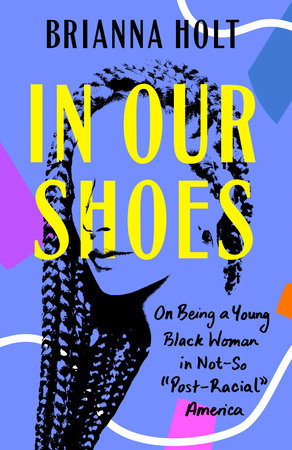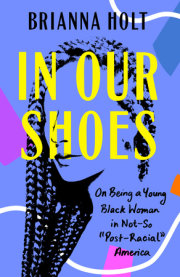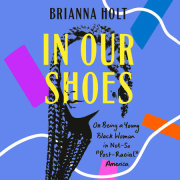Chapter 1
It's Different in My Body
I started working on the proposal for this book when I was twenty-five, and then writing the book itself when I was twenty-six. The material has been in development since 1994— seven months before my birth, when my mother attended her first prenatal visit upon finding out she was pregnant with me at forty-three. Because of her mature age, family and friends frequently questioned her about her health. Doctors warned her about the risk she was taking by getting pregnant just years before menopause was expected. She was told her chances of complications like high blood pressure and preeclampsia were increased. It was likely that I could be born with Down syndrome and even more likely that my mother would need a C section. Only the latter took place, and I was prematurely cut from my mother’s belly a month before my due date. Age- related risks aside, the chances that my mother would have endured complications throughout the course of her pregnancy were much higher than those of her white counterparts, and her likelihood of dying from pregnancy-related complications was three to four times more likely. These alarming stats suggest that even before I was born, simply by coming from a Black woman, it was predetermined that my life mattered less.
Disappointingly, the troubles that affected my mother almost thirty years ago are currently affecting Black millennial and Gen Z women today. Just five years before I was born, Black women in 1990 had a 3.3 times greater chance of dying from pregnancy-related complications than white women. Today, Black women are still three to four times more likely to die from a pregnancy-related complication than white women. Despite medical advancements in pregnancy and childbirth, we are the demographic whose conditions have improved the least. Compared to white women, the maternal mortality ratio for Black women was 2.4 times greater in 1940, 3.6 times greater in 1950, 4.1 times greater in 1960, 3.9 times greater in 1970, 3.4 times greater in 1980, and 3.3 times greater in 1990. In 2020, the maternal mortality rate for Black women was 55.3 deaths per 100,000 live births, 2.9 times the rate for white women (19.1) and 3 times the rate for Hispanic women (18.2). Even prominent Black women, with access to the best doctors and medical facilities, are unable to dodge the harms of racial and implicit bias in medicine. Both Beyoncé and Serena Williams have been vocal about how childbirth almost cost them their lives, respectively pointing to our increased risk of preeclampsia and potential neglect by healthcare staff. But it wasn’t so much the horror stories of Black celebrities that solidified, for me, that America doesn’t care about Black mothers or their children, as it was the opinions of people in power.
During a Politico interview with Senator Bill Cassidy, the response to a question regarding Louisiana’s high rates of women dying in childbirth confirmed that regard for Black women is nonexistent. “About a third of our population is African American,” he said. “African Americans have a higher incidence of maternal mortality. So, if you correct our population for race, we’re not as much of an outlier as it’d otherwise appear. Now I say that not to minimize the issue but to focus the issue as to where it would be.” The quote, which aired publicly, was all at once disturbing and yet crystallizing for me.
My grandfather and his family are from Louisiana, and I instantly thought of my female cousins who live there and have to reckon with this sort of disregard for their lives. Because a third of Louisiana’s population is Black, there isn’t a minor outlier to “correct for.” But to say the state doesn’t have a problem if a third of that population is removed from the pool, a third of which is Black, suggests the ludicrous and racist ideology of several people who have the power to alleviate this crisis but have failed to do so since my own birth.
I sat across from my mom two summers ago, my baby album in her hands, as she painted a picture of the days leading up to February 21 in 1995. It wasn’t the uncertainty she felt that startled me the most but, instead, the doctor’s sentiments in response to her concerns at the time. “Whenever I sought reassurance from the doctor about the delicacy of this pregnancy, he’d tell me, ‘Don’t worry, Black female babies always make it, they are very strong.’ You were still in my stomach. Can you believe those were his words of encouragement?” my mother said. It was with that line of advice that she let go of her fears, holding on to that notion for the remainder of her pregnancy. She explained that her doctor was adamant about it, often reiterating that he always witnessed the most strength with Black female babies. It’s hard to say whether he had decided against telling my mother, too, that she is a strong Black woman because she is of lighter complexion, with hazel eyes and soft curls—she isn’t exactly the visibly presenting Black woman who is typically associated with strength. But her child, me—the daughter of a dark-skinned Black man, who was also attending doctor’s visits with my mom—was instantly perceived as a strong Black baby. Trusting authority, my mother would even pass along the belief as an assuring rebuttal to anyone who would comment on her age as a risk factor and remind people that the survival rate was much higher for preemie Black female babies. She didn’t have access to a worldwide web of thousands of voices that called out the “strong Black woman” stereotype, and so, ignorantly, like many people of the boomer generation, my mother didn’t find a problem with this label, owing to the lack of knowledge at the time. I don’t know too many young Black women who would accept that same opinion from a doctor today.
It comes as no surprise that the doctor’s claim is not backed by science. Nor is it surprising that a non-Black doctor would place a characteristic like “strength” on an unborn child, especially a Black female child. But this belief, that Black women and girls exude strength, doesn’t necessarily stem from a place of endearment or high regard.
Like so many of the other labels placed upon us, our so‑called strength dates back to 1619, when slavery was established in the United States. It was believed that Black women could handle emotional and physical stress in ways that other women could not because of the harsh conditions white people subjected their slaves to. By working on plantations, all while enduring physical, emotional, and sexual abuse, and being fed the worst food and given inadequate healthcare, Black women were forced into the role of superhumans with a high pain threshold. As the University of Virginia’s Seanna Leath found in her studies about harm associated with the expectation of strength in Black women and girls, Black women are often described as superwomen and our bodies are, often unconsciously, viewed as superhuman. Leath writes,
This is typically meant as a compliment and received positively when compared to other, blatantly negative stereotypes about Black women that cast them as sexually aggressive, lazy, loud, and ghetto. In my research interviews with young Black women, Ifind that many consider strength a birthright ofBlack womanhood. They view their survivalamidst the legacies of slavery, colonialism, and disenfranchisement as a testament to the strength of Black women in U.S. society.
Additionally, a 2016 study of 222 white medical students in the Proceedings of the National Academy of Sciences found that half the participants believed Black patients feel less pain than white patients, a medical myth that dates back to medical experiments by white doctors on enslaved Black people in the 1820s. Even in 2021, this myth continues to be perpetuated by medical doctors and workers in healthcare and plays out in the lower quality of healthcare that Black people receive in comparison to their white counterparts. According to the American Bar Association, Black patients are discharged earlier from the hospital than white patients, after surgery—at a stage when discharge can be dangerous or risky; Black patients are more likely to receive less desirable treatments for illness; and Black patients suffering from bipolar disorder are more likely to be prescribed antipsychotics despite evidence that these medications have long-term negative effects and do not produce effective results. In fact, a study observing four hundred hospitals across the United States revealed that Black patients with heart disease received cheaper and older treatments than their white counterparts. More specifically to Black women, they are less likely than white women to receive radiation therapy in conjunction with a mastectomy. Actually, they are less likely to receive mastectomies at all.
So, when my mother’s Middle Eastern doctor predicted I wouldn’t die in the womb because “Black female babies are the strongest babies,” he assumed that my mother, too, would be fine. Despite her age, despite her child being premature, her doctor believed my Blackness defied the odds. This expectation of strength has worked its way into every aspect of my life. Whether it be my non-Black friends and peers comforting me with “you’re so strong” during times of turmoil or my own family members encouraging me to “push through” impossible situations that warrant rest, I’ve always been expected to be okay and deal with whatever unfair obstacles are thrown my way. It’s safe to assume that the majority of these absurd expectations exist for me largely because I am in a Black woman’s body.
As I’ve transitioned from a dependent, sheltered child raised in the South to an independent adult living and working in New York City, it’s become ever so evident that strength is not the only attribute associated with existing in a Black, dark-skinned, woman’s body. All at once my body, my presence, is intimidating and sometimes perceived as unapproachable to non-Black people, while also undeniably beautiful and often imitated. Other times it means moving between the lines of invisible and hypervisible.
As a teen, being invisible and hypervisible became particularly apparent to me through the reactions of non- Black parents and authority figures. During awards ceremonies, sporting events, and various outings with my white friends, I saw how my Blackness brought people to suspect negative things about my character, my intentions, and my intelligence. I once remember the disbelief and discontent expressed on the faces of white parents at a scholarship ceremony when I was awarded the largest grant. The award was preceded by a lengthy application process, extensive in‑person interviews with board members, and multiple long-form essays. Whether these parents were just upset that their child didn’t get the award, or they believed I wasn’t deserving of the award, I’ll never know. But the frequency of these negative reactions and total shock at my achievements by white parents makes me think the latter. At tennis tournaments, white parents would blow up in smoke when their daughters lost to me and would ask them, “How did you let her beat you?” When I announced to the family of one of my close friends, who was white, that I got into the University of Texas, instead of congratulating me, my friend’s mom responded, “Really? I wonder why Jess didn’t get in, then.” At an early age, I realized my hard work, which involved making good grades, long hours of practicing tennis, and joining numerous extracurriculars to prepare myself for future opportunities, had been invisible to some of the white people around me, because they still met my achievements with disbelief and bias.
This kind of bias didn’t stop at school. When shopping with a white friend at the mall, I saw how my Blackness cast me as “the friend,” the one next to the girl deemed deserving of phenomenal customer service. Anytime my friend and I visited the mall, I longed to be approached by a salesperson at one of the many booths to ask if they could style my hair for free or offer me a perfume sample. When we’d walk into Abercrombie, the sales associates would eagerly try to recruit my friend for a job while I’d stand there trying to figure out what it was about her that was so gravitational. Rarely would they glance in my direction or acknowledge my existence as I stood beside her. But that all changed when we lingered in a store. Oftentimes, the longer we stayed in a store and browsed through the aisles, the more all eyes were suddenly on me. Inexplicably, the store associates would glance over from their registers to make sure I wasn’t slipping anything into my bag. We’d make eye contact frequently in the mirrors tacked on the ceiling. In some cases, someone would approach me multiple times to ask if I needed help finding anything, reminding me that I was being watched and that I was expected to do something criminal. This transition, from being invisible to hypervisible, was confusing, especially since middle school was the first time I started to become aware of it. Such innocence and little life experience didn’t provide me with an explanation for why this was happening, but I was always aware of feeling othered, or different from my white friends.
Copyright © 2023 by Brianna Holt. All rights reserved. No part of this excerpt may be reproduced or reprinted without permission in writing from the publisher.






